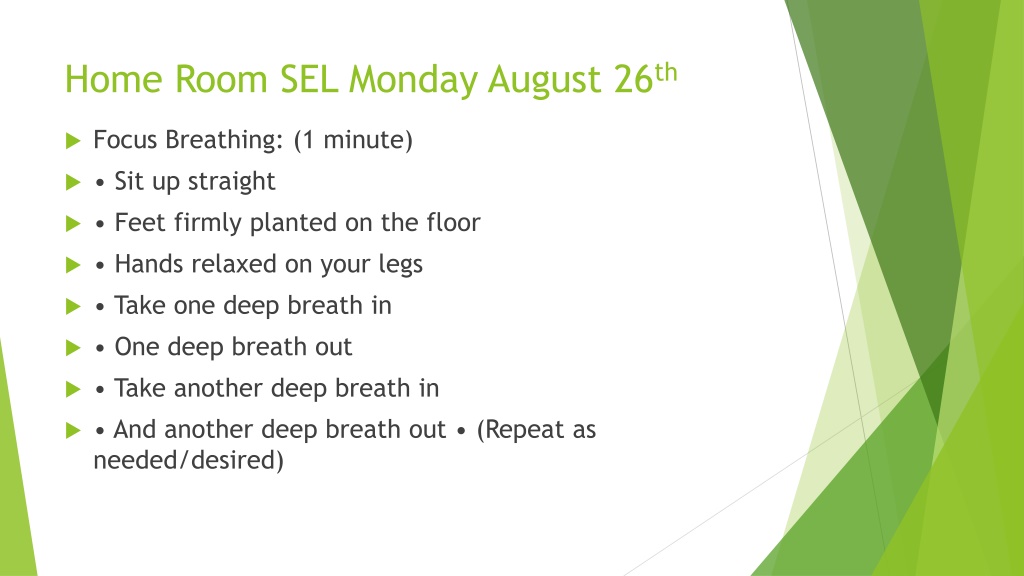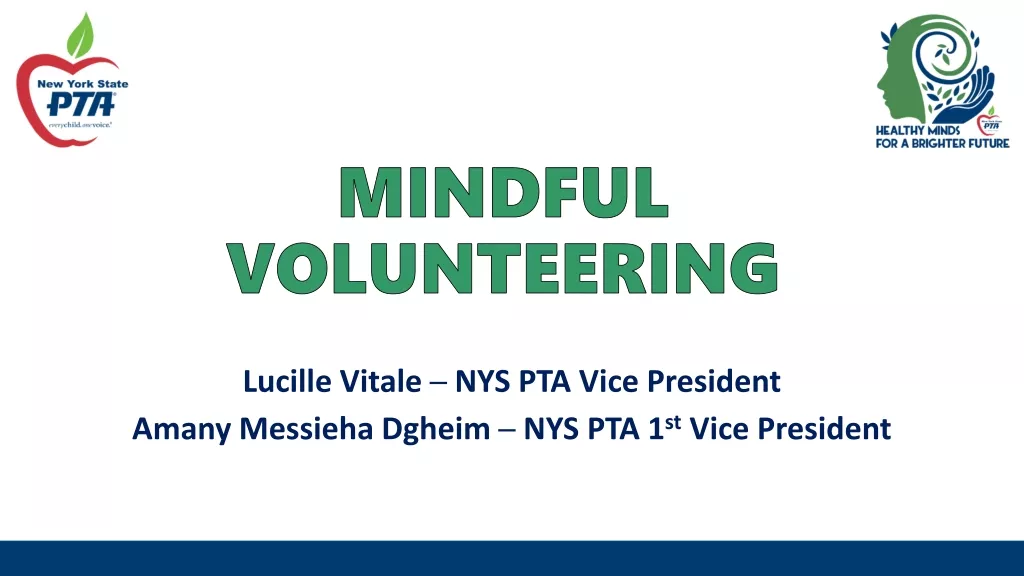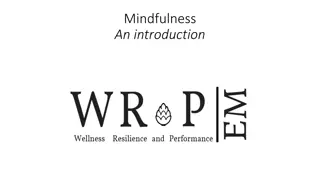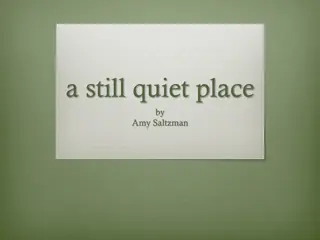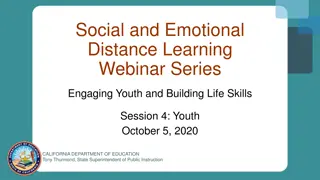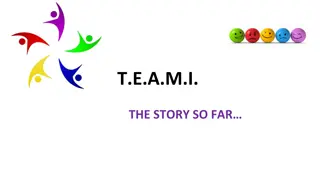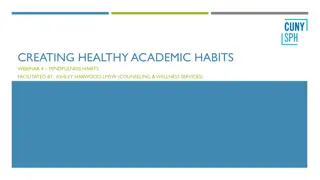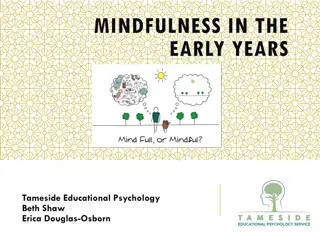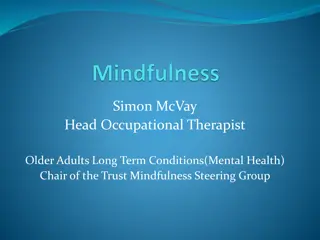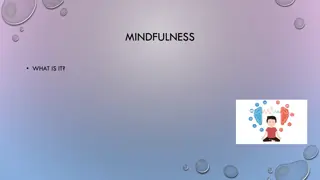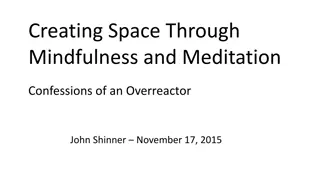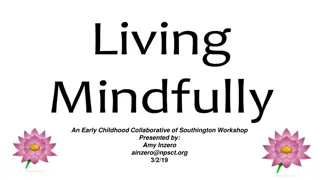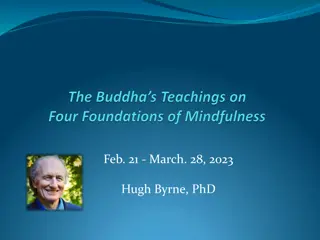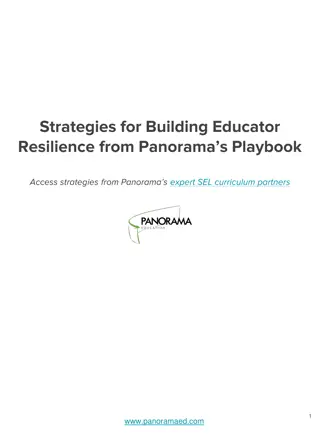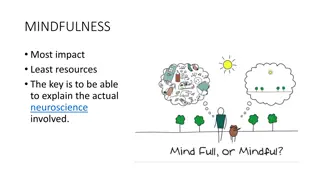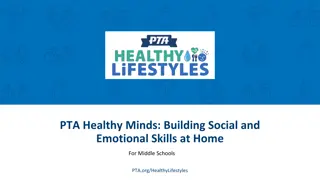Mindfulness and Social-Emotional Learning Activities for SEL Monday
Engage in mindfulness practices like deep breathing, participate in SEL Champs activities to enhance social skills, and enjoy group activities like Mrs. Marbles to promote laughter and bonding. Followed by debrief discussions and reflection questions to encourage emotional expression and understanding. Optional extended lessons available for further exploration. Check out the detailed schedule for a fulfilling SEL Monday experience.
Download Presentation

Please find below an Image/Link to download the presentation.
The content on the website is provided AS IS for your information and personal use only. It may not be sold, licensed, or shared on other websites without obtaining consent from the author. Download presentation by click this link. If you encounter any issues during the download, it is possible that the publisher has removed the file from their server.
E N D
Presentation Transcript
Home Room SEL Monday August 26th Focus Breathing: (1 minute) Sit up straight Feet firmly planted on the floor Hands relaxed on your legs Take one deep breath in One deep breath out Take another deep breath in And another deep breath out (Repeat as needed/desired)
SEL Champs C=0 when teacher speaks and provides instruction H= none A=Don t crack a smile M= Getting in a circle P= Looks like students getting into a circle and waiting for the teacher to provide instruction. If teacher raises hand remain at a conversation zero. S=Check for success
Activity Group Activity: (20 minutes) Mrs. Marbles 1. The point is to pass a simple message around the circle without showing your teeth (as if your mouth is full of marbles) 2. First participant says to the one on the left, Hi! Have you seen Mrs. Marbles? That participant responds, No I haven t but let me ask my neighbor! The process is repeated around the circle 3. When someone smiles or laughs, the questioning stops briefly and begins again with the person who laughed 4. The activity continues until the message gets around the circle without interruption of smiling or laughing Adaptations: One person is it and stands in center of the circle. It approaches each circle participant with the same question. It can add body gestures to provoke or laughing. Notes: Good for relieving group tension
Conversation and debrief C=0 when teacher speaks and provides instruction level 2 with partner H= partner A=Discussion M= Stand up, hands up and pair up P= Looks like students pairing up and waiting for teacher to present questions. Student with the longest hair will go first S=Check for success
Debrief Questions Turn and Talk as you answer the below questions. What made it so difficult to express yourself? How important is to take your time and think before you share with someone when you are upset? How can this activity break the ice when getting to know new peers in class? Explain why a smile is universal.
Extended lesson if needed (scroll down to video connectors (Your choice) go to https://sciencebuddy.net/sel/ C=0 during video H=none A= Video connector M=none P= Looks like students listening and making observation about the video. When the video is complete discuss as a group the questions presented. S=Check for success
Announcements: (3 minutes) (This is where you can state how/what you want students to do to transition into the class. You can also address any classroom or school announcements)
Exit Breathing Focus Breathing: (1 minute) Sit up straight Feet firmly planted on the floor Hands relaxed on your legs Take one deep breath in One deep breath out Take another deep breath in And another deep breath out (Repeat as needed/desired)
Bell work on New Sheet of Paper August 26 Cindy predicts that plastic foam insulates cold drinks better than metal or ceramic materials do. To test the hypothesis, she fills cups made from these materials with equal amounts of cold water. She records the temperature of the water in each cup, using scientific thermometers, every 10 minutes until the water reaches room temperature. Which of these conditions must be the same for this experiment to be valid? A. the thermometer that is in each cup B. the starting temperature of the water in each cup C. the ending temperature of the water in each cup D. the material that makes up each cup
Objective Today I will take a safety test and identify variables So that I can (1) measure my gains regarding lab safety (2) Explain the difference between independent, dependent and control. I know I have it when I have scored a 70 percent or higher and completed my handout with 100 percent accuracy.
Monday August 25thTest Set UP C=0 H=none A= Safety Test M=none P= (1) Write your name on your scantron and bubble in 000 then I.D. Number. (2) Set your folders up and wait quietly as I pass out Safety Test. (3) When you are finished raise your hand and I will collect your safety test. S= 70 percent or higher
Bell Work August 27th Most hypotheses of experiments are not accepted until other scientists verify the results. Which process occurs when one scientist carries out the same procedures used by another in order to verify the results? A. repetition B. replication C. trial D. validation
Bell Work August 28 What can be concluded about the bacteria from reading this graph? A. They thrive at exactly 30 C. B. They cannot tolerate temperatures above 50 C. C. They prefer temperatures between 20 C and 30 C. D. They prefer warmer temperatures to cooler temperatures
Objective Today I will investigate changes that result in an experiment for the soybean lab. So that I can identify (1)the difference between independent and dependent variables. (2) I will also list the steps of the scientific method and explain each step. I know I have it I can identify each type of variable in the investigations and match the steps of the scientific method.
Procedure 2 Moisture Fill each cup with dry soil. Place the probe putting on setting for moisture. Take two readings, first insert into soil then rotate 180 and take second reading. Record on page 3 at the bottom.
Procedure 3 PH wet Soil Fill each cup with dry soil. Place the probe putting on setting for PH. Take two readings, first insert into soil then rotate 180 and take second reading. Record on page 5 at the bottom.
Procedure 4 Temperature Fill each cup with dry soil. Place the thermometer putting on setting for moisture. Take two readings, first insert into soil then rotate 180 and take second reading. Record on page 7 at the bottom.
Procedure Preparing Seeds Measure soy bean seed for a,b,c,d and control. (3 seedling) on page 9-13
Identifying Variable Worksheet (Dont write on paper) C= 0 when teacher speaks and level 2 with a partner H= partner A= Identifying variables M=none P= Rally Coach (1) partner (A) solves and explains to partner (B) will watch, listen, coach, check and praise. (2) (B) will solve and explain to partner (A) will watch, listen, coach, check and praise. Continue back in forth until done. S= Check for success
Lets Practice For the following experiments, define the IV (independent variable), DV (dependent variable), and CG (control group). 1. Different rose bushes are grown in a greenhouse for two months. The number of flowers on each bush is counted at the end of the experiment. IV Different rose bushes DV The number of flowers on each bush
2. You water three sunflower plants with salt water. Each plant receives a different concentration of salt solutions. A fourth plant receives pure water. After a two-week period, the height is measured. IV Each plant receives a different concentration of salt solutions DV A fourth plant receives pure water. CG height is measured
3. Three redwood trees are kept at different humidity levels inside a greenhouse for 12 weeks. One tree is left outside in normal conditions. The heights of the trees are measured once a week. IV Three redwood trees are kept at different humidity levels inside a greenhouse DV One tree is left outside in normal conditions CG The heights of the trees are measured once a week
4. Pea plant clones are giving different amounts of water for three-week period. The first pea plant receives 400 milliliters a day. The second pea plant receives 200 milliliters a day. The third pea plant receives 100 milliliters a day. The fourth pea plant does not receive any extra water: the plant only receives natural ways of receiving water. The heights of the pea plants are recorded daily. IV Pea plant clones are giving different amounts of water for three-week period DV The fourth pea plant does not receive any extra water: CG The heights of the pea plants are recorded daily.
5. One tank of gold fish is fed the normal amount of food once a day. A second tank is fed twice a day. A third tank is fed four times a day during a six week study. The fish s weight is recoded daily. IV Fish fed different amounts of food DV One tank of gold fish is fed the normal amount of food once a day CG The fish s weight is recoded daily.
6. You decide to clean the bathroom. You notice that the shower is covered in a strange green slime. You try to get rid of this slime by adding lemonade juice. You spray half of the shower with lemonade juice and spray the other half of the shower with water. After 3 days of spraying equal amounts 3 times a day, there is no change in the appearance of the green slime on either side of the shower. IV Use of lemonade juice to get rid of slime DV the change left in the amount of green slime CG shower side with water
7. You decide to clean your bedroom. You notice that your floor is covered with clothes. You try to get rid of the clothes by throwing them into the air. You throw clothes from 1/3 of the room into the closet and a second 1/3 of the room straight up in the air. The last 1/3 of the room you leave the clothes on the floor. After 30 minutes of cleaning the floor of the room is now visible. IV Different ways of getting rid of clothes DV the amount of visible clothes seen in bedroom CG clothes left on the floor
8. You want to test which size of soccer ball is easiest to juggle with your feet. You test a size 3, size 4, and size 5 ball. You count the seconds the ball stays in the air for each of the trials. You allow yourself to use both of your feet, knees, and head to juggle the ball. IV Which size ball is easiest to juggle DV amount of seconds ball stays in the air.
Matching Challenge C= 2 with group H= group A= Matching Review M= none P= Looks like student matching the cards as a group then raising their hands when done. When all groups of are done check how well you did. (2) Speed battle, without looking each member will try to match the cards but they are not allowed to look at the projector. S= (Check for success) Winner will receive a ticket and
Check point C=0 H=none A= Check for Understanding M= none P= Looks like students answering questions that check for understanding. Raise you hand when you have the answer. S=Check for success
Check Point 1. Renee rolls a steel ball down a ramp. She conducts multiple trials by releasing the ball from varying heights on the ramp. For each trial, she measures and records the release height of the ball and the distance the ball travels away from the ramp before falling to the ground. The figure below shows the experiment. In this experiment, which variable is the dependent variable? A. distance traveled by the ball B. path of ball once it leaves the ramp C. height from which the ball is released D. time is takes the ball to hit the ground
2. Check point Explain how would you identify an independent variable from a dependent in an experiment.
3. Maria and Lauren are preparing for the Science Fair. They want to learn about how fast a rose bush grows. They choose plants of equal height and each student takes one bush home. They agree to grow their plant inside and to give it 25 milliliters (mL) of water every other day. After one month, the girls compare their results. They find that Maria's plant has grown much taller than Lauren's. The girls are confused by these results. What should the girls have done differently to insure their methods were similar? A. chosen a different plant to work with B. used better soil with more organic matter in it C. recorded the heights of the plants every day of the month D. controlled other variables such as how much sunlight the plants got
Scientific Method Story Champs C=2 with group H= group A= Identifying variable and observation M= none P= Looks like students reading story. # Paper 1-6 as a group and as you are answering questions place only the number of the sentence next to answer. Conversation 0 as we debrief. S= Check for success.
Scientific Method Story #1 You and your friend are walking along a beach in Maine on January 15, at 8:00 am. You notice a thermometer on a nearby building that reads -1 C. You also notice that there is snow on the roof of the building and icicles hanging from the roof. You further notice a pool of sea water in the sand near the ocean. Your friend looks at the icicles and the pool and says, "How come the water on the roof is frozen and the sea water is not?" You answer, "1 think that the salt in the sea water keeps it from freezing at -1 C." You go on to say, "And I think under the same conditions, the same thing will happen tomorrow." Your friend asks, "How can you be sure?" You answer, "I'm going to get some fresh water and some salt water and expose them to a temperature of-1 C and see what happens."
1. In which statement is a prediction made? "1 think that the salt in the sea water keeps it from freezing at -1 C. 2. Which statement states a problem? "How come the water on the roof is frozen and the sea water is not? 3. In which statement is an experiment described? "I'm going to get some fresh water and some salt water and expose them to a temperature of-1 C and see what happens."
4. Which statement contains a hypothesis? "1 think that the salt in the sea water keeps it from freezing at -1 C." You go on to say, "And I think under the same conditions, the same thing will happen tomorrow." 5. Which statements contain data? January 15, at 8:00 am. You notice a thermometer on a nearby building that reads -1 C. 6. Which statements describe observations? You also notice that there is snow on the roof of the building and icicles hanging from the roof. You further notice a pool of sea water in the sand near the ocean.
Analyzing Elements of the Scientific Method 1. Which statement(s) contain conclusions? I suggest that the reason sea water freezes at a lower temperature is that sea water contains dissolved salts, while fresh water does not. 2. Which statement(s) contains a hypothesis? "If sea water has salt in it, it will freeze at a lower temperature than fresh water."
3. Which statement(s) contain observations? 4. Which statement(s) describe an experiment?
Bus Link https://busramp.wixsite.com/shields
7thPeriod Video after Class https://www.youtube.com/watch?v=BL8Fh_HVr7o
Soil Lab Dry soil Test Moist soil Test Seed measurement and planting
